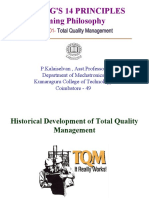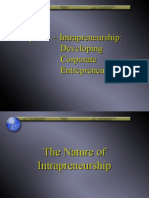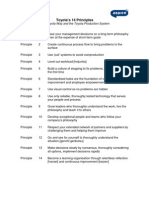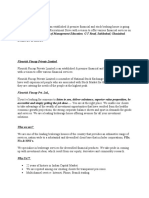Los 14 Pasos Del Modo Toyota
Los 14 Pasos Del Modo Toyota
Uploaded by
Soque XSCopyright:
Available Formats
Los 14 Pasos Del Modo Toyota
Los 14 Pasos Del Modo Toyota
Uploaded by
Soque XSOriginal Description:
Original Title
Copyright
Available Formats
Share this document
Did you find this document useful?
Is this content inappropriate?
Copyright:
Available Formats
Los 14 Pasos Del Modo Toyota
Los 14 Pasos Del Modo Toyota
Uploaded by
Soque XSCopyright:
Available Formats
strana .
1
MANAGEMENT SYSTEMS
4P Model
14 TOYOTA WAY PRINCIPLES
1P: Philosophy: Long-Term Philosophy
2P: Process: The Right Process Will Produce the Right Results
3P: People and Partners:
Add Value to the Organization by Developing Your People and Partners
4P: Problem Solving:
Continuously Solving Root Problems Drives Organizational Learning
1P: Long-Term Philosophy
Principle 1. Base your management decisions on a long-term philosophy, even at
the expense of short-term financial goals.
Have a philosophical sense of purpose that supersedes any short-term decision
making. Work, grow, and align the whole organization toward a common purpose
that is bigger than making money. Understand your place in the history of the
company and work to bring the company to the next level. Your philosophical
mission is the foundation for all the other principles.
Generate value for the customer, society, and the economy it is your starting
point. Evaluate every function in the company in terms of its ability to achieve this.
Be responsible. Strive to decide your own fate. Act with self-reliance and trust in
your own abilities. Accept responsibility for your conduct and maintain and improve
the skills that enable you to produce added value.
2P: The Right Process Will Produce the Right Results
Principle 2. Create continuous process flow to bring problems to the surface.
Redesign work processes to achieve high value-added, continuous flow. Strive to
cut back to zero the amount of time that any work project is sitting idle or waiting for
someone to work on it.
Create flow to move material and information fast as well as to link processes and
people together so that problems surface right away.
Make flow evident throughout your organizational culture. It is the key to a true
continuous improvement process and to developing people.
Principle 3. Use pull systems to avoid overproduction.
Provide your downline customers in the production process with what they want,
when they want it, and in the amount they want. Material replenishment initiated by
consumption is the basic principle of just-in-time.
Minimize your work in process and warehousing of inventory by stocking small
amounts of each product and frequently restocking based on what the customer
actually takes away.
Be responsive to the day-by-day shifts in customer demand rather than relying on
computer schedules and systems to track wasteful inventory.
strana . 2
MANAGEMENT SYSTEMS
Principle 4. Level out the workload (heijunka). (Work like the tortoise, not the hare)
Eliminating waste is just one-third of the equation for making lean successful.
Eliminating overburden to people and equipment and eliminating unevenness in
the production schedule are just as important yet generally not understood at
companies attempting to implement lean principles.
Work to level out the workload of all manufacturing and service processes as an
alternative to the stop/start approach of working on projects in batches that is
typical at most companies.
Principle 5. Build a culture of stopping to fix problems, to get quality right the first
time.
Quality for the customer drives your value proposition.
Use all the modern quality assurance methods available.
Build into your equipment the capability of detecting problems and stopping itself.
Develop a visual system to alert team or project leaders that a machine or process
needs assistance. Jidoka (machines with human intelligence) is the foundation for
building in quality.
Build into your organization support systems to quickly solve problems and put in
place countermeasures.
Build into your culture the philosophy of stopping or slowing down to get quality
right the first time to enhance productivity in the long run.
Principle 6. Standardized tasks are the foundation for continuous improvement
and employee empowerment.
Use stable, repeatable methods everywhere to maintain the predictability, regular
timing, and regular output of your processes. It is the foundation for flow and pull.
Capture the accumulated learning about a process up to a point in time by
standardizing todays best practices. Allow creative and individual expression to
improve upon the standard; then incorporate it into the new standard so that when
a person moves on you can hand off the learning to the next person.
Principle 7. Use visual control so no problems are hidden.
Use simple visual indicators to help people determine immediately whether they
are in a standard condition or deviating from it.
Avoid using a computer screen when it moves the workers focus away from the
workplace.
Design simple visual systems at the place where the work is done, to support flow
and pull.
Reduce your reports to one piece of paper whenever possible, even for your most
important financial decisions.
strana . 3
MANAGEMENT SYSTEMS
Principle 8. Use only reliable, thoroughly tested technology that serves your
people and processes.
Use technology to support people, not to replace people. Often it is best to work
out a process manually before adding technology to support the process.
New technology is often unreliable and difficult to standardize and therefore
endangers flow. A proven process that works generally takes precedence over
new and untested technology.
Conduct actual tests before adopting new technology in business processes,
manufacturing systems, or products.
Reject or modify technologies that conflict with your culture or that might disrupt
stability, reliability, and predictability.
Nevertheless, encourage your people to consider new technologies when looking
into new approaches to work. Quickly implement a thoroughly considered
technology if it has been proven in trials and it can improve flow in your processes.
3P: Add Value to the Organization by Developing Your People
and Partners
Principle 9. Grow leaders who thoroughly understand the work, live the
philosophy, and teach it to others.
Grow leaders from within, rather than buying them from outside the organization.
Do not view the leaders job as simply accomplishing tasks and having good
people skills. Leaders must be role models of the companys philosophy and way
of doing business.
A good leader must understand the daily work in great detail so he or she can be
the best teacher of your companys philosophy.
Principle 10. Develop exceptional people and teams who follow your companys
philosophy.
Create a strong, stable culture in which company values and beliefs are widely
shared and lived out over a period of many years.
Train exceptional individuals and teams to work within the corporate philosophy to
achieve exceptional results. Work very hard to reinforce the culture continually.
Use cross-functional teams to improve quality and productivity and enhance flow
by solving difficult technical problems. Empowerment occurs when people use the
companys tools to improve the company.
Make an ongoing effort to teach individuals how to work together as teams toward
common goals. Teamwork is something that has to be learned.
Principle 11. Respect your extended network of partners and suppliers by
challenging them and helping them improve.
Have respect for your partners and suppliers and treat them as an extension of
your business.
Challenge your outside business partners to grow and develop. It shows that you
value them. Set challenging targets and assist your partners in achieving them.
strana . 4
MANAGEMENT SYSTEMS
4P: Continuously Solving Root Problems Drives Organizational Learning
Principle 12. Go and see for yourself to thoroughly understand the situation
(genchi genbutsu).
Solve problems and improve processes by going to the source and personally
observing and verifying data rather than theorizing on the basis of what other
people or the computer screen tell you.
Think and speak based on personally verified data.
Even high-level managers and executives should go and see things for
themselves, so they will have more than a superficial understanding of the
situation.
Principle 13. Make decisions slowly by consensus, thoroughly considering all
options; implement decisions rapidly.
Do not pick a single direction and go down that one path until you have thoroughly
considered alternatives.
Nemawashi is the process of discussing problems and potential solutions with all of
those affected, to collect their ideas and get agreement on a path forward. This
consensus process, though time-consuming, helps broaden the search for
solutions, and once a decision is made, the stage is set for rapid implementation.
Principle 14. Become a learning organization through relentless reflection (hansei)
and continuous improvement (kaizen).
Once you have established a stable process, use continuous improvement tools to
determine the root cause of inefficiencies and apply effective countermeasures.
Design processes that require almost no inventory. This will make wasted time and
resources visible for all to see. Once waste is exposed, have employees use a
continuous improvement process (kaizen) to eliminate it.
Protect the organizational knowledge base by developing stable personnel, slow
promotion, and very careful succession systems.
Source: Jeffrey K. Liker, The Toyota Way: 14 Management Principles from the Worlds
Greatest Manufacturer, McGraw-Hill, 2004.
You might also like
- Independent State of Papua New Guinea V PNG Sustainable Development Programe (2016) 2 SLR 0366Document76 pagesIndependent State of Papua New Guinea V PNG Sustainable Development Programe (2016) 2 SLR 0366Benjamin TanNo ratings yet
- Calabarzon: Regional Physical Framework Plan 2017-2046Document234 pagesCalabarzon: Regional Physical Framework Plan 2017-2046monique mhekie dogenio100% (3)
- Supply Chain Management: Strategy, Planning, and Operation, 5/e Authors: Sunil Chopra, Peter Meindl and D. V. KalraDocument26 pagesSupply Chain Management: Strategy, Planning, and Operation, 5/e Authors: Sunil Chopra, Peter Meindl and D. V. KalraDevid LuizNo ratings yet
- Success and Failure of ToyotaDocument9 pagesSuccess and Failure of ToyotaMuthukumar KalyanaramanNo ratings yet
- 14 Principals of ToyotaDocument4 pages14 Principals of Toyota6sahaniNo ratings yet
- Executive Summary of The 14 Toyota Way PrinciplesDocument5 pagesExecutive Summary of The 14 Toyota Way Principlesmuhammad naufalNo ratings yet
- The 4 Sections and The 14 Principles of The Toyota WayDocument6 pagesThe 4 Sections and The 14 Principles of The Toyota WayJessica LaguatanNo ratings yet
- The Toyota Way To Lean LeadershipDocument15 pagesThe Toyota Way To Lean LeadershipNisha WalawalkarNo ratings yet
- Chapter 5 Toyota Production SystemDocument24 pagesChapter 5 Toyota Production System21124375No ratings yet
- The 14 Principles of The Toyota WayDocument4 pagesThe 14 Principles of The Toyota Waybsushma23No ratings yet
- Edwards Deming's 14 Points For Total Quality ManagementDocument4 pagesEdwards Deming's 14 Points For Total Quality ManagementCyril Grace BoocNo ratings yet
- Toyota Way HandoutDocument4 pagesToyota Way HandoutVirojana TantibadaroNo ratings yet
- TareaDocument2 pagesTareaMariP.GómezNo ratings yet
- History: Toyota Started As Loom Manufacturer and Later On As An Automobile ManufacturerDocument5 pagesHistory: Toyota Started As Loom Manufacturer and Later On As An Automobile ManufactureramrinderNo ratings yet
- Deming's Contribution To TQMDocument7 pagesDeming's Contribution To TQMMythily VedhagiriNo ratings yet
- Lean Manufacturing NotesDocument59 pagesLean Manufacturing NotesABISHEK G.ANo ratings yet
- CHAPTER 13 - Toyota Production System 14 PrinciplesDocument10 pagesCHAPTER 13 - Toyota Production System 14 PrinciplessamNo ratings yet
- Leadership Guide - How To Achieve Operational ExcellenceDocument22 pagesLeadership Guide - How To Achieve Operational ExcellenceJoseph VindolloNo ratings yet
- Sbaa 7030Document86 pagesSbaa 7030farayi.gadahNo ratings yet
- Deming's Fourteen Points For Management: Prepared By: BERJOHN BTAHAN D4A - Bs Industrial EngineeringDocument16 pagesDeming's Fourteen Points For Management: Prepared By: BERJOHN BTAHAN D4A - Bs Industrial EngineeringJohn BathersonNo ratings yet
- Deming'S 14 Principles Deming Philosophy: Total Quality ManagementDocument30 pagesDeming'S 14 Principles Deming Philosophy: Total Quality ManagementKalaiselvan PunniyamoorthyNo ratings yet
- The Toyota Way by Jeffrey Liker: 14 Management Principles From The World's Greatest ManufacturerDocument20 pagesThe Toyota Way by Jeffrey Liker: 14 Management Principles From The World's Greatest ManufactureralexminayaNo ratings yet
- 14 Principles of Toyota Way - Empowerment TechnologiesDocument2 pages14 Principles of Toyota Way - Empowerment TechnologiesAldrich BunyiNo ratings yet
- Deming's 14-Point Philosophy: A Recipe For Total QualityDocument5 pagesDeming's 14-Point Philosophy: A Recipe For Total QualityAikeen Pelongco LataNo ratings yet
- Deep ChangeDocument14 pagesDeep ChangeGeo ByteNo ratings yet
- Agile Values and PrinciplesDocument17 pagesAgile Values and PrinciplesshanthiNo ratings yet
- BME01.HM3C.chapter 2 - Roa - GiovanniDocument10 pagesBME01.HM3C.chapter 2 - Roa - Giovannigiovanni roaNo ratings yet
- Leadership: (Chapter 2 Part-II)Document23 pagesLeadership: (Chapter 2 Part-II)maimoonasaleemNo ratings yet
- The Toyota WayDocument40 pagesThe Toyota WaySandarsh SureshNo ratings yet
- 14 Toyota Way PrincipleDocument1 page14 Toyota Way PrincipleGopal KrishnanNo ratings yet
- Notes On Lean ManufacturingDocument15 pagesNotes On Lean ManufacturingOmar NaeemNo ratings yet
- The Toyota Way by Jeffrey Liker: ENMA 284: Lean Manufacturing Systems Overview - Derived FromDocument18 pagesThe Toyota Way by Jeffrey Liker: ENMA 284: Lean Manufacturing Systems Overview - Derived FromHaytham Elsherief100% (1)
- Chapter 3 - Intrapreneurship: Developing Corporate EntrepreneurshipDocument18 pagesChapter 3 - Intrapreneurship: Developing Corporate EntrepreneurshipFaizan Ahmad NazirNo ratings yet
- Concept of TQMDocument5 pagesConcept of TQMYash gawasNo ratings yet
- Lec 7Document11 pagesLec 7Satyam jhaNo ratings yet
- Implementing LeanDocument37 pagesImplementing LeanVishnuNo ratings yet
- Entrep Q2 Mod7 4Ms of OperationDocument8 pagesEntrep Q2 Mod7 4Ms of OperationAnatanya TironaNo ratings yet
- Researcher's Findings - 14 Principles: Section I - Long-Term PhilosophyDocument5 pagesResearcher's Findings - 14 Principles: Section I - Long-Term PhilosophymuhammadajkhanNo ratings yet
- Total Quality MGT 3 KaizenDocument32 pagesTotal Quality MGT 3 KaizenBrezel NuyadNo ratings yet
- Sir Deming'S 14 Points FPR TQM: Submitted To: Sir - Asad Raza GardeziDocument6 pagesSir Deming'S 14 Points FPR TQM: Submitted To: Sir - Asad Raza GardeziSufi SoulNo ratings yet
- MF F418 Lean Manufacturing: BITS PilaniDocument31 pagesMF F418 Lean Manufacturing: BITS PilaniAbhijeetNo ratings yet
- Lean Manufacturing Essentials: Hands-on help for small manufacturers and smart technical people: No Nonsence Manuals, #1From EverandLean Manufacturing Essentials: Hands-on help for small manufacturers and smart technical people: No Nonsence Manuals, #1Rating: 3.5 out of 5 stars3.5/5 (2)
- Toyota 14 PrinciplesDocument1 pageToyota 14 PrinciplesKunal RathiNo ratings yet
- Lean Manufacturing Final 10 1579967509841Document27 pagesLean Manufacturing Final 10 1579967509841Mohamed IbrahimNo ratings yet
- The Three Quality Philosophies ComparedDocument12 pagesThe Three Quality Philosophies ComparedRamesh AlhatNo ratings yet
- Submitted by Anand Raj PatelDocument46 pagesSubmitted by Anand Raj PatelOmkar Pradeep KhanvilkarNo ratings yet
- The Toyota WayDocument7 pagesThe Toyota WayJulie Merrill0% (1)
- The Total Quality Approach To Quality Management: Achieving Organizational ExcellenceDocument16 pagesThe Total Quality Approach To Quality Management: Achieving Organizational ExcellenceKhabirIslamNo ratings yet
- In Trap Renu Re ShipDocument21 pagesIn Trap Renu Re ShipShakeel AhmadNo ratings yet
- Designing Work Standards and Manpower PlanningDocument58 pagesDesigning Work Standards and Manpower PlanningShiena AcedoNo ratings yet
- 2 LECT TQM 2024 quality priciplesDocument43 pages2 LECT TQM 2024 quality priciplesdepressedpigeon4No ratings yet
- Module 4Document53 pagesModule 4Yash KamalNo ratings yet
- Quarter 4 ENTREPRENEURSHIP WEEKS 1 3Document26 pagesQuarter 4 ENTREPRENEURSHIP WEEKS 1 3May Alvarez MagsinoNo ratings yet
- ReportsssDocument6 pagesReportsssVia SahipaNo ratings yet
- 14 Toyota-Way Principles: Section I - Long-Term PhilosophyDocument4 pages14 Toyota-Way Principles: Section I - Long-Term PhilosophydebusahaNo ratings yet
- Entrep Q4 MODULE 1Document20 pagesEntrep Q4 MODULE 1Christopher BuzarangNo ratings yet
- Deming's 14 Point Philosophy: Presentation OnDocument17 pagesDeming's 14 Point Philosophy: Presentation OnSomendra KumarNo ratings yet
- W e DemingDocument32 pagesW e DemingNikhil ShettyNo ratings yet
- Demings System of Knowledge & BPRDocument15 pagesDemings System of Knowledge & BPRrishavNo ratings yet
- ReportsssDocument7 pagesReportsssSAHIPA, Via S.No ratings yet
- TQM Assignment-6Document5 pagesTQM Assignment-6api-282599777No ratings yet
- The Toyota Way PrinciplesDocument4 pagesThe Toyota Way PrinciplesGinanjar Hadi PrasetyoNo ratings yet
- LEAN ENTERPRISE: Transforming Organizations Through Agile Principles and Continuous Improvement (2023 Guide for Beginners)From EverandLEAN ENTERPRISE: Transforming Organizations Through Agile Principles and Continuous Improvement (2023 Guide for Beginners)No ratings yet
- CSA - Cultivating CommunitiesDocument13 pagesCSA - Cultivating CommunitiesAvantgardens100% (1)
- Hazard Identification Dan Risk Assessment (Hira) Pada: Pengoperasian Forklift Di Pt. Bangun Sarana Baja - GresikDocument12 pagesHazard Identification Dan Risk Assessment (Hira) Pada: Pengoperasian Forklift Di Pt. Bangun Sarana Baja - GresikGeneral Affair Chen Woo FisheryNo ratings yet
- Fahad Ali 086 Complete Assignment PC, SCOPE, WBS, TMDocument11 pagesFahad Ali 086 Complete Assignment PC, SCOPE, WBS, TMsaba.zubairNo ratings yet
- The Dabbawala System: On Time Delivery Every Time: Group - 02Document9 pagesThe Dabbawala System: On Time Delivery Every Time: Group - 02Saumya GautamNo ratings yet
- 12 Tanada v. Angara - DIGESTDocument2 pages12 Tanada v. Angara - DIGESTSaima RodeuNo ratings yet
- Obs 015Document109 pagesObs 015haftebojaNo ratings yet
- Ethiopian Fishery Sub-Sector Analysis - Draft ReportDocument130 pagesEthiopian Fishery Sub-Sector Analysis - Draft ReportYared FikaduNo ratings yet
- RFP 92-2020 Sanctioned Homeless Encampment Services (Final Draft)Document22 pagesRFP 92-2020 Sanctioned Homeless Encampment Services (Final Draft)Kyreon LeeNo ratings yet
- Appendix 1 AnswersDocument84 pagesAppendix 1 AnswersTiya AmuNo ratings yet
- MKT201, BCG MatrixDocument4 pagesMKT201, BCG MatrixRaffay SamdanNo ratings yet
- Wordpress EbookDocument10 pagesWordpress Ebooknamng000666No ratings yet
- ETS Honoraria Payment Calendar: For StaffDocument1 pageETS Honoraria Payment Calendar: For StaffSolomon KimNo ratings yet
- East Khasi Hills FormattedDocument72 pagesEast Khasi Hills FormattedchaitanyasharafNo ratings yet
- Flourish FincapDocument3 pagesFlourish FincapprashanttripathiNo ratings yet
- Thesis Smart HomeDocument5 pagesThesis Smart Homejencloudcleveland100% (2)
- BCG 2022 Annual Sustainability Report Apr 2023Document104 pagesBCG 2022 Annual Sustainability Report Apr 2023Aditya SinghNo ratings yet
- A Project Work Report Main Thesis (Binita Tharu)Document25 pagesA Project Work Report Main Thesis (Binita Tharu)krishantchy100No ratings yet
- Aecom Africa Cost Guide 2024Document56 pagesAecom Africa Cost Guide 2024Wakatinka QSNo ratings yet
- StretchLab - 2021-04-10 - FDD - Xponential FitnessDocument258 pagesStretchLab - 2021-04-10 - FDD - Xponential FitnessFuzzy PandaNo ratings yet
- All BooleanDocument78 pagesAll BooleanRashid SaiyedNo ratings yet
- IPPB-SO-IT-Recruitment-2024-NoticeDocument1 pageIPPB-SO-IT-Recruitment-2024-Noticepalrakesh02042002No ratings yet
- Article - Corrosion Under Insulation (CUI)Document3 pagesArticle - Corrosion Under Insulation (CUI)doctor_arvind2003No ratings yet
- Random Sampling DemoDocument61 pagesRandom Sampling DemoDionisia Rivera Dita100% (1)
- I. A. Background of The StudyDocument9 pagesI. A. Background of The StudyJUARE MaxineNo ratings yet
- Labour Law - II ObjectivesDocument4 pagesLabour Law - II Objectivesaswin donNo ratings yet
- CV Wynto Updated FEB 2023Document2 pagesCV Wynto Updated FEB 2023Syahrakansa PutraNo ratings yet
- Budgets and Budgetary ControlDocument46 pagesBudgets and Budgetary ControlnehaNo ratings yet

























































































